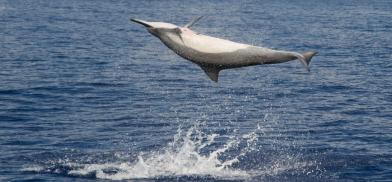
A decade after the Gangetic Dolphins were declared national aquatic animals, Prime Minister Narendra Modi on Saturday on the occasion of the 74th Independence Day announced Project Dolphin to give a stronger impetus for conservation of the species in the lines of Project Tiger and Project Elephant.
It envisages to address conservation concerns and empower the stakeholders like the river-dependent population in reducing the river pollution and allowing sustainable fishery and river-based other livelihood options through scientifically oriented conservation methods, the ministry said.
"We will also launch 'Project Dolphin' for protecting ocean and Gangetic dolphins," he said from the ramparts of the Red Fort.
The Ministry of Environment, Forest and Climate Change has made elaborate plans to launch the 10-year project 'Gangetic Dolphin' led by Environment Minister Prakash Javadekar.
The Gangetic River Dolphin is found in the Ganga-Brahmaputra-Meghna and Karnaphuli River system of India, Nepal and Bangladesh. Platanista gangetica gangetica is a species of freshwater dolphins primarily found in the Ganga and Brahmaputra rivers and their tributaries in India, Bangladesh and Nepal.
In India, these dolphins are sighted along deep river reaches in Assam, Bihar, Jharkhand, Madhya Pradesh, Rajasthan, Uttar Pradesh and West Bengal.
As per the assessment reports available, there are about 3,700 Gangetic River Dolphins in the Indian river systems.
River dolphins act as ideal ecological indicators of healthy riverine ecosystems. They are the flagship species for monitoring the conservation status of rivers and were declared National Aquatic Species in 2010.
Implementation of the "Project Gangetic Dolphin" envisions a healthy river ecosystem not only protecting the biodiversity of the river but also taking into consideration the wellbeing of the people depending on its resources.
"The project would also work in close tandem and cooperation and support of various Ministries/Departments/Scientific Organizations/Civil Society Organizations etc. like the Ministry of Jal Shakti, Ministry of Shipping, Ministry of Agriculture & Farmers Welfare, Ministry of Fisheries, Animal Husbandry and Dairying, Ministry of Power, Ministry of Rural Development, State Governments, etc," the ministry stated.
Several million people depend on the River Ganga for their sustenance. Conservation of Gangetic Dolphins will, therefore, benefit not only the survival of the species, but also, the people dependent on the river system for their livelihood.
Being an indicator species of river ecosystems, conservation of the Gangetic River Dolphin would also ensure controlling river pollution and thereby improving the availability of fishes and enhancing economies of local communities through sustainable fishery, eco-tourism and others. (IANS)
